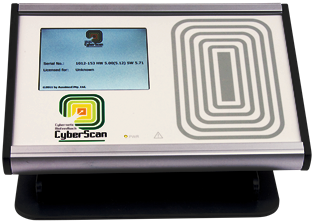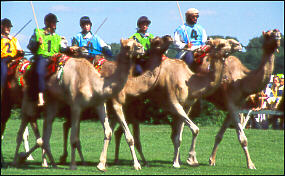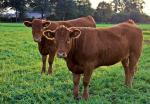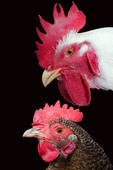A Tool for All Veterinary and Livestock Fields

Whatever you are or do - wherever you live, this is the only tool you need to protect and improve
your products, the Cyberscan.
Radionik, Bioresonance, and Biofeedback in one device. Everything is compact and mobile in a single device, powered by an AC power supply or battery power. The device fits - together with your laptop - into a standard briefcase.
Animal Care

Horses were usually used as working animals in earlier times. Now they have a permanent place in leisure and sports. The horse, being a highly developed mammal, is susceptible to all kinds of diseases and health disorders just like humans. For most horse owners, the horse is considered "part of the family" but is also a valuable asset. Cyberscan considers both the sentimental and the pecuniary value of the horse realistically and work to make Cyberscan an effective tool for horse wellness.
A breeding or racing horse, the most noble purpose for which a horse may be used, can represent a very high monetary value.
 Whether a horse is seen in a more sentimental or competitive light, the owners are concerned about not only keeping the horses in good health and thus ensuring their availability and readiness, but also making them healthier if possible.
Whether a horse is seen in a more sentimental or competitive light, the owners are concerned about not only keeping the horses in good health and thus ensuring their availability and readiness, but also making them healthier if possible.
Using a Cyberscan "Farmer's Choice" edition can not only restore and preserve the health of the animal but also improve the performance without doping.
 For example, the following disease patterns are readily available in the CyberTrone database:
For example, the following disease patterns are readily available in the CyberTrone database:
Anemia - Andrological Problems - Anhidosis - Ataxia - Atypical Weidemyopathy - Conjunctivitis - Blockade of ISG - Bornache Disease - Borreliosis - Botulism - Cauda Equina Neuritis - Chips (OCD) - COB - Cushing's Syndrome - Dematophilosis - EOTRH - Equine sarcoidosis - Equine viral arteritis - Ankle ring syndrome - Biliary disease - Biliary tract infections - Cervical spine syndrome - Cervical spine syndrome - Cerebral palsy - Cervical spine syndrome - Bone fracture - Hoof cartilage - Hoof cancer - Hoof cartilage ossification - Infectious anemia - Influenza - Caries - Carpal tunnel syndrome - Cataract - Laryngeal disease - Jaw fracture - Kissing spine - Inflammation of the spleen - malignant melanoma - metabolic syndrome - spleen diseases - lunar bluntness (ERU) - motoneuron disease - Tendon injury - sweet itch - spat - salivary stones - blight rot - tetanus - tear and nasal channel blockade - over reaching - poisoning - stuck knee disc - warts - West Nile fever - White Line Disease - wild meat - wound care - tooth problems - tongue injuries - Diaphragmatic fracture

Horse racing is one of the oldest sports known to humans. Racing specific horses are primarily used for selective breeding.
Horse racing has been a popular leisure activity for humans for centuries. Keeping a racehorse in good shape is expensive and risky. Doping animals to enhance their performance is not allowed and can have detrimental consequences.
If you are a breeder, owner of a racing stable, keeper of race horses, racing camels, or racing dogs (greyhounds) you should carefully read the information about the other animals given on this website. These also apply to the sport of racing.
 A readymade racing car has the same technical features as a vehicle specially tuned for racing. However, it will never come close to the performance of a tuned vehicle.
A readymade racing car has the same technical features as a vehicle specially tuned for racing. However, it will never come close to the performance of a tuned vehicle.
The same applies to animals. Even the noblest of horses cannot compete with a "tuned" horse despite special training. If all the organs or systems of the body work perfectly, then even the last reserves of energy are made available. It is these last reserves of energy that make a difference between the first and other positions.
Cyberscan "Farmer's Choice" edition tunes the energies of the animal until an optimal balance is achieved. This makes doping unnecessary and is not illegal in horse racing.

Cattle are one of the most important sources of food for humans. There are about 1.4 billion cattle across the world and the demand is increasing.
Diseases in cattle breeding and farming or just poor output implies financial losses for the breeding and farming industry.
 The use of Cyberscan "Farmer's Choice" edition can keep the livestock healthy and ensure optimal output at the same time.
The use of Cyberscan "Farmer's Choice" edition can keep the livestock healthy and ensure optimal output at the same time.
For example, the following disease patterns are readily available in the Cyberscan "Farmer's Choice" edition database:

Acetonemia - Aujeszky's disease - tapeworm - brucellosis - BSE - Lichen - calf diarrhea - Ringworm - calf dysentery - ketosis - Osteomalacia - Coccidia - Head mange - liver fluke - Leukemia - lungworm - mastitis - Foot-and-mouth disease - ruminal acidosis - rumen - parasites - rickets - mange - bovine flu - Trunk mange - Salmonellosis - Tail mange - rabies - Tuberculosis - grass tetany
The global trend towards mega-farming not only ensures profitability and higher yields but there is also an increasing risk of disease. Even in Germany, such mega-farms have up to 65,000 animals. According to an article published in the magazine "Stern", the weekly output is up to 1600 pigs (150 tons).
Since the demand for pork is rising rapidly, more and more mega-farms are coming up. In the new German federal states alone, five new plants with a capacity of 75,000 to 95,000 animals are planned.
The average number of animals held in German stalls is 225.

The U.S. already has farms with 240,000 animals.
The cost of preventive treatment against diseases and epidemics increases with the density of livestock. The global competition is increasing dramatically since many emerging countries can produce more cheaply and unhindered by the European standards on livestock husbandry. Thus, farms in the U.S produce a kilo of pork for € 1.12 - which costs only € 0.76 in Brazil!
In addition to this, there is the ever-growing desire of consumers to be able to buy healthy meat. The resentment of meat that is contaminated with chemicals and drugs is constantly growing.
The preventive or simultaneous treatment of animals with Cyberscan "Farmer's Choice" edition could generate significant economic benefits.

87,584,830 tons of poultry meat was produced in 2007. The biggest producers are the United States, the People's Republic of China, and Brazil. 82% of poultry meat in the United States is chicken meat and 17% is turkey meat. In the People's Republic of China, 71% of poultry meat is chicken meat, 15% is duck meat and 14% is goose and guinea fowl meat. In Brazil, 97% of poultry meat is chicken meat. 40% of the world's egg production comes from China.
The EFSA (European Food Safety Authority) considers the following problems as serious:
Conventional laying battery
Low bone strength and bone fractures during depopulation No possibility for elementary behaviors
No possibility for elementary behaviors
Small furnished cages
Feather pecking and cannibalism in flocks where the beaks are not securedLimited scope for exercising elementary behaviors
Free range breeding
Bone fractures during the laying of eggs
Feather pecking and cannibalism in flocks where the beaks are not secured
High risk of parasitic diseases
More than 75% of egg-laying hens are kept in cages in Europe.
The cost of preventive treatment against diseases and epidemics increases with the density of livestock. The global competition is increasing dramatically since many emerging countries can produce more cheaply unhindered by the European standards on livestock husbandry.
In addition to this, there is the ever-growing desire of consumers to be able to buy healthy meat. The resentment of meat that is contaminated with chemicals and drugs is constantly growing.
The preventive or simultaneous treatment of animals with Cyberscan "Farmer's Choice" edition could generate significant economic benefits. The description of the Cyberscan system applies to all living things.

Sheep are one of the oldest and most important domestic animals for humans. It played a significant role even during the previous centuries due to its versatile uses - e.g. wool, meat, milk, hides and skins, intestines, etc.
Although wool production is no longer so important, we still see a significant increase in global meat production.
In 1980, about 6.5 million tons of sheep meat was produced which grew to around 11.3 million tons in 2001 and the trend is still rising.
The production of sheep milk will become more important in the future. This growing importance is simply because more and more people are becoming allergic to the components of cow's milk which are difficult to digest. This is probably a consequence of the increasing number of food additives, chemicals, and radiation exposure.
What has already been mentioned for cattle and pigs, also applies to sheep farming and breeding. The trend is towards larger farms with increasing livestock density. The resulting increased risks in terms of disease, epidemics, and injuries can be reduced in sheep by using Cyberscan "Farmer's Choice" edition and the results can be improved.

The essence of the veterinary profession is defined in the professional code of conduct for veterinarians:
- § 1 of the Federal Veterinarian Act says:
"The veterinarian is appointed to prevent, alleviate, and heal the suffering and diseases of animals, to contribute towards preserving and developing capable livestock, to help protect people from the danger and damage caused by animal diseases and to protect food and products of animal origin and to work towards increasing the quality of foods of animal origin. The veterinary profession is not a trade. It is a free profession by nature. The veterinarian is the appointed protector of animals."
 The foremost responsibility of the veterinarian is to "prevent, alleviate and heal the suffering and diseases of animals and to contribute towards preserving and developing capable livestock". As in the case of human medicine, even veterinarians mostly have only pharmaceutical products to carry out their many responsibilities. Since around 1900, when "pharmaceutical medicine" was born, age-old knowledge has been increasingly lost. Veterinarians are moving very slowly towards the so-called "alternative" healing methods.
The foremost responsibility of the veterinarian is to "prevent, alleviate and heal the suffering and diseases of animals and to contribute towards preserving and developing capable livestock". As in the case of human medicine, even veterinarians mostly have only pharmaceutical products to carry out their many responsibilities. Since around 1900, when "pharmaceutical medicine" was born, age-old knowledge has been increasingly lost. Veterinarians are moving very slowly towards the so-called "alternative" healing methods.
Cyberscan "Farmer's Choice" edition is the preferred choice here. Without using drugs and other remedies, energy information is used to communicate directly with the immune system of the animal which is stimulated to heal itself. Such a method is less expensive than conventional methods in many cases. Moreover, it is extremely effective and can be safely used even in bio-stocks.